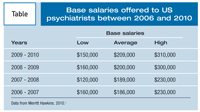Publication
Article
Psychiatric Times
Demand for Psychiatrists Continues to Grow
Author(s):
If surveys conducted by physician recruiting companies accurately reflect current trends in the job market, the news is very good for psychiatrists-and less promising for many patients with mental health disorders.

If surveys conducted by physician recruiting companies accurately reflect current trends in the job market, the news is very good for psychiatrists-and less promising for many patients with mental health disorders. Chief among those who may not receive the psychiatric care they need are children and adolescents and people who live in areas that are not densely populated.1-3
According to the results of a recently released survey by the national physician search firm Merritt Hawkins, psychiatrists are in great demand these days. In fact, the need for psychiatrists is rising faster than for physicians in any other specialty.1
That survey tracked more than 2800 physician recruiting assignments that the company conducted between April 1, 2009, and March 31, 2010.1 The company received 179 requests for psychiatrists during that period, which represents a 47% increase in demand from 2009 and a 121% increase from 2007.
Mark Smith, president of Merritt Hawkins, cites a combination of factors that are driving a psychiatrist shortage that “could soon reach crisis levels.” A key factor is the the increasing incidence of psychiatric problems-including stress and depression from financial worries and unemployment-stemming from the current economic downturn. Moreover, the number of patients with mental health disorders continues to grow as the population increases and ages, and as the psychological toll of 2 wars continues to mount.
What’s unusual about the growing need for psychiatrists is that it is occurring in an economy that has generally inhibited the recruitment of physicians in other specialties. Across the country, tight capital markets have significantly limited financial resources that hospitals, medical groups, and other health care providers need to recruit new physicians. In many health care facilities, hiring has been put on hold. Some state-supported institutions, correctional facilities, for example, are increasingly relying on locum tenens physicians to fill staffing gaps.4
It’s no surprise then that the US Department of Health and Human Services has designated 3143 Health Professional Shortage Areas for Behavioral Health throughout the country, where 80 million people now live. That number is only expected to grow. Consequently, more and more Americans may not get the psychiatric services they need. Given the relative paucity of child and adolescent psychiatrists, youngsters with mental health disorders are particularly vulnerable.

The laws of supply and demand also account for the sharp increase in demand for psychiatrists. More than half of psychiatrists in this country are older than 50, and many are approaching retirement. The number of newly minted psychiatrists lags behind the numbers of those who are about to retire. (More and more medical students are pursuing careers in dermatology or radiology.) Currently, nearly one-third of psychiatrists in this country are international medical graduates.
The Bureau of Health Professions predicts that demand for general psychiatry services will have increased nearly 20% between 1995 and 2020. The Bureau also foresees a 100% increase in the need for child and adolescent psychiatric services during that period.
These demands may be contributing to the increase in average incomes for psychiatrists (Table).
References:
Image © TheiSpot.com





